
Centaurea is a genus of over 700 species of herbaceous thistle-like flowering plants in the family Asteraceae. Members of the genus are found only north of the equator, mostly in the Eastern Hemisphere; the Middle East and surrounding regions are particularly species-rich. In the western United States, yellow starthistles are an invasive species. Around the year 1850, seeds from the plant had arrived to the state of California. It is believed that those seeds came from South America.
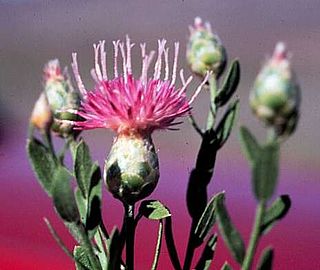
Rhaponticum repens, synonyms including Acroptilon repens and Leuzea repens, with the common name Russian knapweed, is a species of bushy rhizomatous perennial, up to 80 cm tall. Stems and leaves are finely arachnoid-tomentose becoming glabrous and green with age. The rosette leaves are oblanceolate, pinnately lobed to entire, 2–3 cm wide by 3–8 cm long. The lower cauline leaves are smaller, pinnately lobed; the upper leaves become much reduced, sessile, serrate to entire. The heads are numerous terminating the branches. Flowers are pink to purplish, the marginal ones not enlarged. The outer and middle involucral bracts are broad, striate, smooth with broadly rounded tips; the inner bracts are narrower with hairy tips. Pappus present with bristles 6–11 mm long. Fruit is a whitish, slightly ridged achene.

Allelopathy is a biological phenomenon by which an organism produces one or more biochemicals that influence the germination, growth, survival, and reproduction of other organisms. These biochemicals are known as allelochemicals and can have beneficial or detrimental effects on the target organisms and the community. Allelopathy is often used narrowly to describe chemically-mediated competition between plants; however, it is sometimes defined more broadly as chemically-mediated competition between any type of organisms. Allelochemicals are a subset of secondary metabolites, which are not directly required for metabolism of the allelopathic organism.

Centaurea diffusa, also known as diffuse knapweed, white knapweed or tumble knapweed, is a member of the genus Centaurea in the family Asteraceae. This species is common throughout western North America but is not actually native to the North American continent, but to the eastern Mediterranean.

A detection dog or sniffer dog is a dog that is trained to use its senses to detect substances such as explosives, illegal drugs, wildlife scat, currency, blood, and contraband electronics such as illicit mobile phones. The sense most used by detection dogs is smell. Hunting dogs that search for game, and search and rescue dogs that work to find missing humans are generally not considered detection dogs but instead under their own categories. There is some overlap, as in the case of cadaver dogs, trained to search for human remains.

Tracking refers to a dog's ability to detect, recognize and follow a specific scent. Possessing heightened olfactory abilities, dogs, especially scent hounds, are able to detect, track and locate the source of certain odours. A deeper understanding of the physiological mechanisms and the phases involved in canine scent tracking has allowed humans to utilize this animal behaviour in a variety of professions. Through domestication and the human application of dog behaviour, different methods and influential factors on tracking ability have been discovered. While tracking was once considered a predatory technique of dogs in the wild, it has now become widely used by humans.
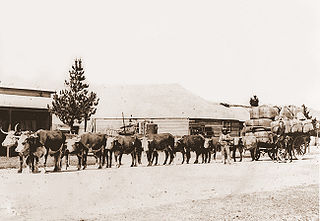
A working animal is an animal, usually domesticated, that is kept by humans and trained to perform tasks instead of being slaughtered to harvest animal products. Some are used for their physical strength or for transportation, while others are service animals trained to execute certain specialized tasks. They may also be used for milking or herding. Some, at the end of their working lives, may also be used for meat or leather.

A search-and-rescue dog is one trained to find missing people after a natural or man-made disaster. The dogs detect human scent and have been known to find people under water, under snow, and under collapsed buildings.
Canine cancer detection is an approach to cancer screening that relies upon the claimed olfactory ability of dogs to detect, in urine or in breath, very low concentrations of the alkanes and aromatic compounds generated by malignant tumors. While some research has been promising, no verified studies by secondary research groups have substantiated the validity of positive, conclusive results.
Chaetorellia acrolophi is a species of tephritid fruit fly known as the knapweed peacock fly. It is used as an agent of biological pest control against noxious knapweeds, especially spotted knapweed.

Cyphocleonus achates is a species of true weevil known as the knapweed root weevil. It is native to southern Europe and the Mediterranean and is used as an agent of biological pest control against noxious knapweeds, especially spotted knapweed. It has recently been spotted in India.
Larinus minutus is a species of true weevil known as the lesser knapweed flower weevil. It is used as an agent of biological pest control against noxious knapweeds, especially diffuse knapweed and spotted knapweed.

Mount Jumbo, also called Mount Loyola by some locals, is a mountain that overlooks the city of Missoula in the U.S. state of Montana. The mountain is northeast of the city's downtown and, in its majority, is publicly owned. In 1996, Jumbo was purchased from private landowners and protected from development. Funding for this purchase came from an open space bond, federal and non-profit agencies and thousands of local contributors. Additional land parcels have been purchased since then, increasing the easement to 1,800 acres (730 ha).
Steve Austin is an Australian dog trainer, who has been training dogs for over 30 years. He is renowned as one of Australia's top animal trainers, with a particular skill in dog behaviour and training. His lifetime in dog training has seen him train animals for quarantine, search and rescue, police work, and wildlife preservation, among other roles. He has also travelled internationally lecturing and training dogs.
Boechera fecunda is a species of flowering plant in the mustard family known by the common names Mt. Sapphire rockcress and bitterroot rockcress. It is endemic to Montana in the United States, where there are twenty known occurrences in three counties.
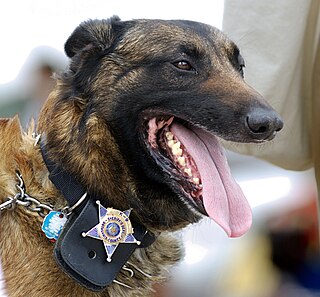
Florida v. Jardines, 569 U.S. 1 (2013), was a United States Supreme Court case which resulted in the decision that police use of a trained detection dog to sniff for narcotics on the front porch of a private home is a "search" within the meaning of the Fourth Amendment to the United States Constitution, and therefore, without consent, requires both probable cause and a search warrant.

Florida v. Harris, 568 U.S. 237 (2013), was a case in which the United States Supreme Court addressed the reliability of a dog sniff by a detection dog trained to identify narcotics, under the specific context of whether law enforcement's assertions that the dog is trained or certified is sufficient to establish probable cause for a search of a vehicle under the Fourth Amendment to the United States Constitution. Harris was the first Supreme Court case to challenge the dog's reliability, backed by data that asserts that on average, up to 80% of a dog's alerts are wrong. Twenty-four U.S. States, the federal government, and two U.S. territories filed briefs in support of Florida as amici curiae.
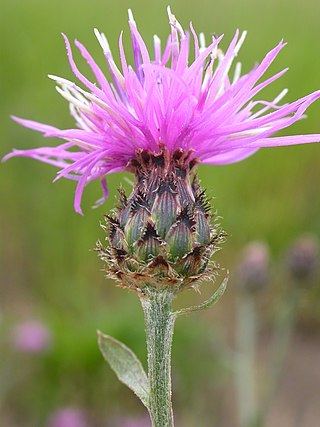
Centaurea stoebe, the spotted knapweed or panicled knapweed, is a species of Centaurea native to eastern Europe, although it has spread to North America, where it is considered an invasive species. It forms a tumbleweed, helping to increase the species' reach, and the seeds are also enabled by a feathery pappus.
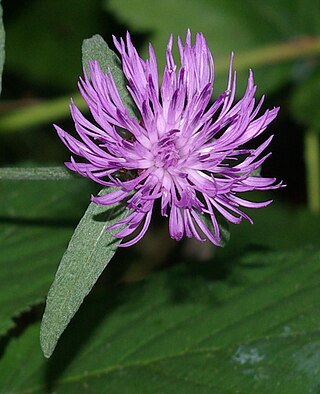
Meadow knapweed, also known as hybrid knapweed or protean knapweed, is a fertile hybrid between black knapweed and brown knapweed. The taxonomic status of the species is uncertain, and meadow knapweed has been variously described as different species.
















